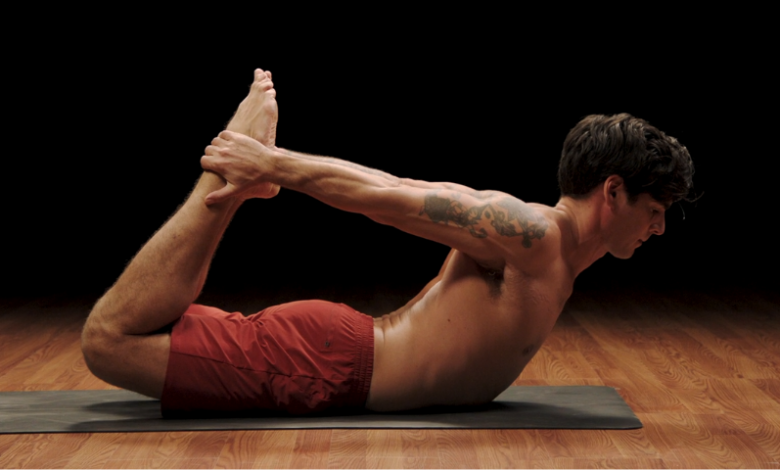How to Do Bow Pose in Yoga (Dhanurasana)


Bow pose (dhanurasana in Sanskrit) is a very challenging yet satisfying backbend. Its difficulty lies in the amount of strength required of the body’s posterior.
Similarly shaped postures like camel pose and bridge pose are often easier to access because of how much leverage the body can exert by pressing down with the limbs. Dhanurasana, on the other hand, offers only the abdomen as a contact point.
Because of your body’s relationship to gravity, the strength required for bow pose must come from the glutes, hamstrings, and upper back to lift your upper and lower body off of the floor. With repetition and perseverance, your body will understand how to move into this pose and experience the benefits of a more mobile spine.
Bow Pose (Dhanurasana): Step-by-Step Instructions
- Lie face down on your mat, legs hip-width apart, forehead resting on stacked hands.
- Press the tops of your feet into the floor and straighten your legs as you tuck your tailbone toward the floor. Observe a subtle lift underneath your navel.
- Lift your forehead off of your hands and lift your chest as you simultaneously firm your buttocks and the backs of your legs toward the floor.
- Reach both of your arms behind you simultaneously, rotating them so your palms face each other, and bend your knees.
- Lift your chest and legs high enough that you can grab the outsides of your ankles or the tops of your feet.
- Keeping your knees hip-width apart, hold your ankles or feet firmly so the backward resistance of your legs helps to keep your chest lifted.
- If your upper back is moving well and you’re able to look upward, give that a try. Avoid throwing your head back, and work on moving your shoulder blades down and away from your ears.
- Hold for 5 to 10 deep breaths. You will be tempted to come out of the pose by simply letting go of your feet. Rather than releasing your body like a slingshot, slowly resist gravity, with the upper and lower bodies landing at the same time.
Beginner Tips for Doing Bow Pose
Play with moving your focus from opening your chest by pulling your legs farther back. Then, try letting your chest move down toward the floor a bit to focus on lifting your legs higher.
Brent Laffoon, instructor in BODi’s Yoga52 series, says, “There’s value in doing it both ways. There’s also a lot to be gained by keeping your weight centered on your belly and trying to lift both the legs and the chest evenly.”
How to Make Bow Pose Easier

- Instead of bending your knees and reaching for your ankles, keep your legs straight and strengthen them by pressing them into the floor and strongly engaging your glutes. This teaches you how to support and lengthen your lower back, rather than hinging at the lumbar spine, the most vulnerable and often injured part of the spine.
- Working your legs straight, practice various arm positions:
- Interlace your hands behind your back and work to lift your chest up by pulling your arms back (also known as bound locust pose).
- Extend your arms straight behind you, and press your palms strongly down into the floor to lift the fronts of your shoulders. Move your shoulder blades toward each other, spreading your collarbones wide apart.
- To modify the full pose, place a long bolster or two folded blankets under the tops of your thighs. Starting off with your legs already lifted shortens the distance needed to reach your feet.
How to Deepen Bow Pose

- Rather than pushing yourself further into bow pose, try holding it longer. Then practice coming out of the pose as slowly and gracefully as possible.
- Once entering and exiting bow pose becomes more effortless, continue to deepen dhanurasana by lifting your feet and the crown of your head toward each other, creating an even higher vertical line.
- Try taking the pose to the side into parsva dhanurasana, or side bow. Maintaining the grip on your ankles, gently rock over completely to one side. In this very different relationship with gravity, feel the floor underneath your side body and tighten up the pose, tucking your tailbone and opening your chest even more. With even amounts of momentum and control, rock back onto your abdomen, take a full cycle of breath, then gently rock to the other side.



